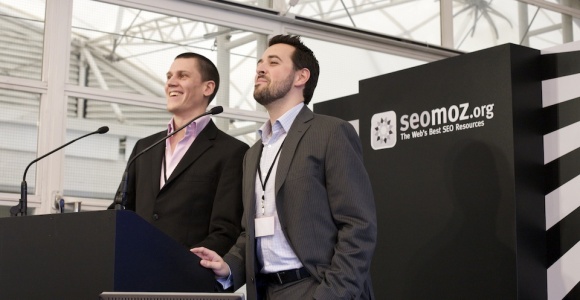
Will Critchlow Rand Fishkin welcome the world to London for SEO Expert Training
Introduction
As an owner of both SEOmoz Basic SEO Training DVD and the SEOmoz Advanced Training DVD, I knew that the speakers knew their stuff and they looked like a fun crowd to boot. So I decided to attend the SEO Expert Training live conference in London on October 19 and 20.
Was the trip to London worthwhile?
Definitely yes, but…
Let’s start with the program which Distilled and SEOmoz organised for us. In a word, superb. The program included dedicated sessions on:
- link building
- site structure
- social campaigns
- SEO tools
- content strategy
- conversion techniques
- SEO team management
- Google penalties and penalty filters
- Google analytics
For the most part this partial list of topics is a dreamlist of issues which I’d like to hear about in depth.
Quicklinks to Day One Presentations:
- Advanced analytics – Will Critchlow
- Getting SEO done against the organisational odds – Richard Baxter
- “ROI from social media” – Lucy Langdon
- “Diagnosing and fixing penalties, understanding guidelines” – Jane Copland
- Scalable site architecture – Duncan Morris
- Ranking Models – Ben Hendrickson
- Live linkbuilding – Tom Critchlow & Rand Fishkin
- Conversion rate optimisation – Ben Jesson and Dr. Karl Blanks
- Some of the Q&A
Quicklinks to Day Two Presentations:
- Head to Head: Keyword Strategy – Will Critchlow
- Head to Head: Keyword Strategy – Rand Fishkin
- News site SEO – Rob Ousbey
- The Pacman Chunk of the Piechart: Getting Links – Tom Critchlow
- SEO is Nothing Without Content – Rand Fishkin
- Google Local Search – Tom Critchlow
- Universal Search – Patrick Altoft
- The limits of automation – Dave Naylor
- The right strategy for your organisation – Will Critchlow
- International Companies: How to handle multiple countries/languages – Duncan Morris
- Question and Answer Day Two SEO Expert Training

Amazing View from the Imagination Gallery
The “but” has to do with the internal structure of the conference. The conference was co-sponsored by SEOmoz and Distilled. Unfortunately for a two day conference, Distilled is just too young and small a company provide authorative speakers for all subjects.
When someone delivered a good speech on day one, there’s a good chance, he or she would follow up with a much weaker overview of another subject. Some of the speakers were too inexperienced to speak to this audience, both as an expert and as a public speaker (I’m thinking particularly of Lucy Langdon’s “ROI in Social Media”). I’m sure Lucy will get better with time, but she wasn’t quite ready yet. A number of the sessions were cribbed from well-known sources, rather than reflecting original thought. I’m thinking specifically of site structure (Jakob Nielsen) and branding strategy (USP standard advertising 101 at this point).
Distilled’s youth on the other hand yielded a big reward on another front: enthusiasm. Both the presenters and the audience were full of excitement and enthusiasm for what we do. As a group we are people who want to make the web a better place, full of stronger and more interesting sites.
For most of us, search is not just a job but a passion.
This was not an IT conference full of introverted programming types who never leave their computers and aren’t getting any exercise. While the gender ration skewed in favour of men by at least four to one, my girlfriend noted with a slight tone of surprise that those who were there are quite attractive.
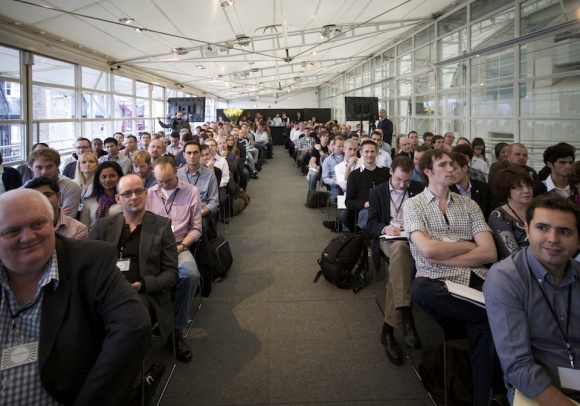
SEO Expert Training audience paying close attention
Another big issue which Distilled got right was venue. We were right next to Goodge Street on the top of the Imagination gallery enclosed in glass with all of London’s Bloomsbury district just out the window. We were bathed in natural light all day long. The location was inspiring. We were just blocks away from Saatchi & Saatchi’s main offices on Charlotte Street in the heart of media London. Small details like attractive platform and graphics from Distilled graphic artist Leonie Wharton made a big difference for a design type like myself.
Some complained about the five story hike up and down by foot to get a cup of coffee. To my mind, that trot up and down stairs improved the conference five fold as neither audience nor speakers ever hit that somnulent too-many-hours-in-a-chair-without-exercise drift. Drowsiness is highly contagious so by keeping everyone awake the quality of attention in the room went up, benefiting both audience and speakers.

Imagination Gallery – the view down
When we organise a conference, I’ll have some trouble finding a location with three or more flights of stairs and no lift. Perhaps we’ll have to bribe someone to take the elevator out of commission.
Advanced analytics – Will Critchlow (Director at Distilled)
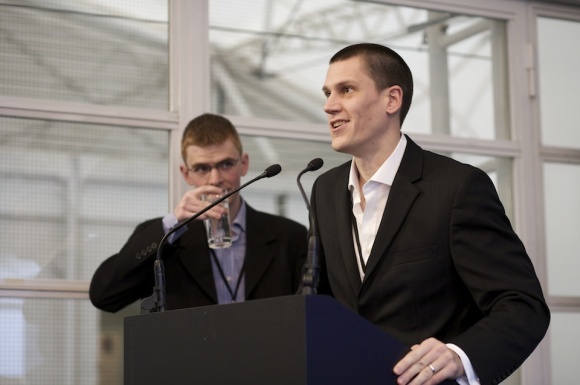
Will Critchlow with Duncan Morris
Will told us how important it is to know your data and gave some great hints on how to use Excel and pivot tables to master data. This presentation seemed incredibly short to me. Perhaps I was just slow getting off the block after all the travel to get here.
Getting SEO done against the organisational odds – Richard Baxter (SEOgadget)
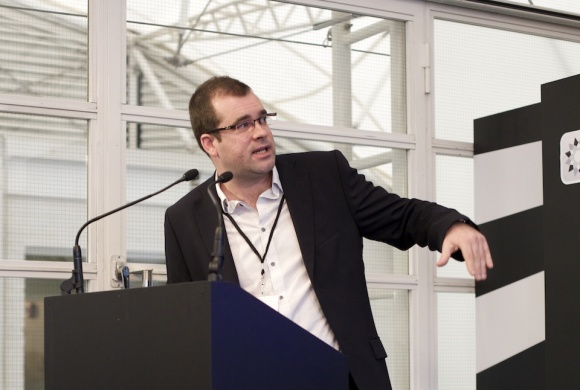
Richard Baxter – How to Build an SEO Team
On the other hand, Richard Baxter’s presentation was right in my area of deep interest. Building and developing an SEO team.
- a good senior SEO needs to be a good manager
- management consultancy to directors
- data to business modelling
- recruiting/training
- helping team
- Good campaign objectives are:
- visibility
- conversion
- revenue (measured monthly)
- traffic
- Segment distinctions in traffic:
- generic = “broadband”
- research = “best broadband”
- purchase = “broadband deals”
- Take each segment to a different page/part of your site.
- When making estimates, tend conservative: you can only win when you exceed your targets.
- How to Structure an SEO team?
- all requests for SEO support should go through manager
- you protect the team from silly requests
- you make sure workload remains balanced across the team
- you maintain the authority within the team to shape it
- you know what management is asking for so you can build more of it into the team
- all requests for SEO support should go through manager
- Training a team
- make them give presentations to you every week
- presentation help them clarify their thoughts
- Four Segments of SEO in a team environment
- Technical
- Content
- Links
- Metric/Analysis
- Ideally you will have at least one person in each area.
- Compartementalize! Focus.
- Recruiting SEO’s for your team
- sell the role! you want good applicants.
- do group interviews: Richard’s current practice:
- bring eight candidates in
- divide to four pairs
- making the pairs each sell you the other one
- hire the one who analyses and sells best
- advertise in the right places
- SEOmoz has a good jobs board
- SEOgadget has a good jobs board
- Reporting to management
- monthly reports
- sell your services monthly with the reports
- maintains engagement and executive support
- keeps SEO team on their toes
- Controlling Staff
- regular meetings
- set questions at these meetings: if someone doesn’t have his/her figures send that person out of the meeting until they can bring them
- team accountable for specific figures/traffic
- set deadlines
- set specific link acquisition targets, ie. 25 mR 4 links or 4 mR 5 links in a month (mR = mozRank)
- regular meetings
- Toolset
- Excel for analysis
- Advanced Web Ranking for ranking reports (flexible, sophisticated)
- Dafizilla Table2Clipboard for getting data out of web table and into Excel
Analysis by Foliovision
I agree with Richard that the future of SEO is not the sole practitioner but the team. So if you plan to advance in this profession, you need to get good at managing people. Unfortunately the analytic and creative functions of SEO have nothing to do with the easy extrovert traits of a natural manager. I’ve been working on myself for the last three years to improve my management skills. It took two years of hard work to get up to basic competence. I now enjoy working with and managing my team, but for over a year it was a lot like daily trips to the dentist.
So Richard really underestimates the challenge here for SEO’s.
I like his ideas about specific accountability and specific targets. I also like the idea of having people work in specific segments so that they can focus on their work. All things we’ve worked on at Foliovision over the last six months. I do not agree that his umbrella model scales well. To keep a lot of balls in the air, the head of agency/senior SEO needs team members to be directly accessible to clients but to remain in copy on the communication.
I also found the Excel solution touted here a bit limited. We used to do a lot of our work in spreadsheets (OpenOffice, Tables and Google docs). But as soon as we find that we regularly need to measure or track anything we build an app to do it. It takes a couple of days of programming time, but the result is far more efficient than loading, formatting and crunching numbers in Excel every time.
SEOmoz does the same thing: their toolset is awesome and eliminates a lot of the need for heavy duty spreadsheet gymnastics. So while I think spreadsheet competence is an asset, I don’t think it’s the way of the future for SEO.
Overall, Richard’s presentation was a frank examination by one experienced inhouse SEO manager about how he played the game (Richard’s gone indie in the last year). Very stimulating.
“ROI from social media” – Lucy Langdon (Search Marketer, Distilled)
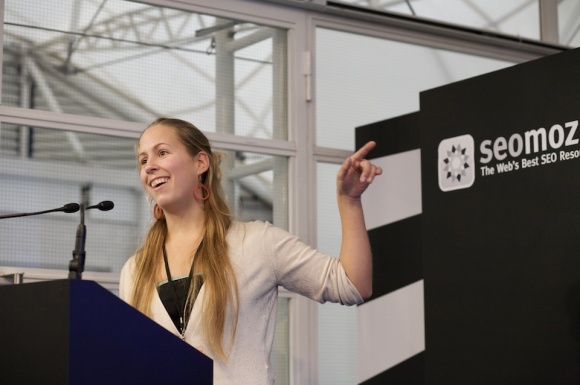
Lucy Langdon – ROI in Social Media: A bit more how to win at it next time please
- start by reading avinash’s post how to measure branding online: [this post is a bit much for a naked recommendation: I think what Lucy was trying to say is measure everything]
- social media can’t fix a broken site
- improve your product first
- for longtail ranking you need authority links
- in social media: think BIG.
- brainstorm properly (go to the pub)
- use your whole team
- steal ideas from your competitors
- Before you start a campaign, make sure you have
- sign off
- fixed budget
- a strong conviction it will work [not sure about this one: social media is pretty hit and miss even for the experts: good golfers shoot lots of birdies but few holes in one]
- what posts have potential to take off:
- data visualisation works:
- resource lists work.
- big images work.
- big pictures from curent events.
- lists work well.
- “Social media is a fickle mistress.”
- How to Track Success
- leading indicators
- visits
- twitter mentions
- visits from a specific network
- bookmarks
- other web mentions
- leading indicators
- Getting It Done
- just write/draw//sing something
- now make it better
- get feedback
- make it better
- publishy
- promotion (have it all ready in advance!)
- all outgoing emails are prepared in advance
- make it shareable in a practical way: buttons to click on
- use social media buttons sparingly: just the ones which you are targeting or which will work
- have some free time to deal with anything that comes up on the day
- set your Google alerts, technorati mentions
- follow up bad links, bad mentions. Get negative publicity fixed within 24 hours.
- tracking: what did you get
- use leading indicators to get additional support to promote further.
- if it doesn’t work, then try to figure out what went wrong.
Analysis by Foliovision
Social media is a great mysterious mess, as she admits herself: “Social media is a fickle mistress”. Lucy Langdon has the formidable task of trying to bring order and predictability to social media success at Distilled.
Order starts with repeatable process, as Richard’s earlier presentation covered. Unfortunately with viral/social media hits, for the moment only a small part can be process-mapped. A large part of is either brilliant writing, great pictures or creative thinking. Still her follow up routine is worth printing out on your wall.
A few more specific examples would have reinforced Lucy’s case. Lucy’s delivery didn’t help as at one point in her presentation her voice tanked on her and she never really recovered. The jokes about going out to the pub to dream up winning social media campaigns fell a bit flat for me, but then again I’m not an Englishman. Perhaps she was serious. We do our brainstorming at the conference table at Foliovision at 11am or 1pm when everyone’s minds are running at full speed.
Either Lucy was holding back some of her best information and her secrets or she’s not quite ready to be a keynote speaker on social media.
“Diagnosing and fixing penalties, understanding guidelines” – Jane Copland (Ayima Search Consultant, ex-SEOmozzer)
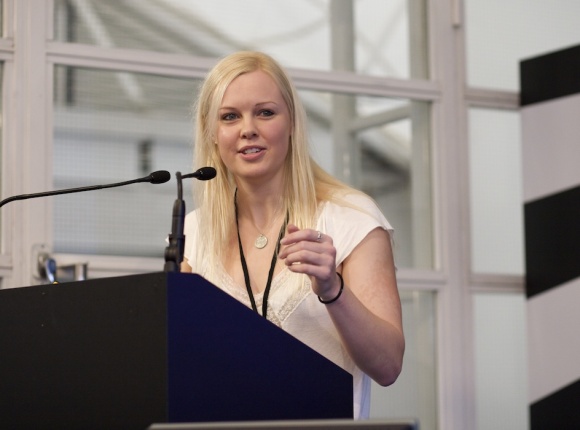
Jane Copland – Diagnosing and Fixing Penalties: Yes Virginia, there is a filter clause.
- Diagnosing and Fixing Penalties
- Penalties are like unicorns. Rarer than you think.
- What you are seeming most of the time are filters, not penalties.
- Caveat: always keep in mind your site might just not be strong enough.
- First thing to do is reanalyse your SERPs as if it was a new project.
- Sample Penalty: overoptimisation of anchor text
- Solution: Stop getting links which say “cheap car loans”.
- Solution: use press releases (uses domain) to add some good links with alternative anchor text.
- Duplicate content: rarely a penalty. But fix it so you don’t send pages to supplemental.
- Vince update favour brands. Google got better at association.
- Avoiding penalties:
- monitor the hell out of SERP activity: every day.
- Watch out for any of the following.
- bouncing SERPs
- inability to rank higher than a certain number.
- If you find alternate pages from your domain ranking instead: focus on alternate page instead of root page. Sometimes we’ve exhausted everything that we could to make home page rank.
- Penalty causes:
- majority of real penalites are brought about because of undesirable linking practices.
- TIP: removing terrible links can improve rankings!!!
- gross on-page spam (hidden content, cloaking)
- majority of real penalites are brought about because of undesirable linking practices.
- Getting out of jail once you are in:
- Start with: take. this. shit. seriously.
- Humans are on the other end. Human review! Site reviewer is not excited about your problem, could care less. S/he has a long list of sites to review. Looking for a reason to deny your request.
- Hiding content for good reason. display: none; remove all these easy fails before you file for reinclusion.
- Human reviewer has got every tool available to google. How many phd’s do they have working at Google? Are you stupid enough to think you can outsmart them?
- Get rid of the grey hat.
- Sample: filthy little secrets – domain.com/links.html
- Solution dump link exchange. At the very least remove all your dodgy links.
- TIP: don’t use your SEO email account for link reinclusion request. Attracts unnecessary attention/scepticisim. Use client’s own domain. Play dumb: externally hired.
- Be patient. Requests can take a month. Don’t resubmit over and over again, especially if your site still has hidden issues.
- If you are denied, go and look and find out what is the problem. diversify something.
Analysis by Foliovision
Jane’s presentation was ruthlessly professional. One felt that Jane has seen her share of penalties and bailed her share of clients out of jail. Her advice about not playing on the dark side, appears to have been learnt first hand or at least from close colleagues. Where Jane has seen all this is a bit of a mystery though, as until recently she was working at SEOmoz, apparently white knights all.
The distinction between a penalty and a filter is a valid one in my experience. We don’t have any penalised sites, but there is one which just can’t seem to stay above 10 for any of the keyphrases for which it should be number one. Jane’s remarks about fixing anchor text concentration and adding some site trust with high end links hopefully will help us bring this client to where he should be. Our particular obstacle is that the client in question doesn’t like any controversial content at all. Hard to bring in earned links for vanilla content.
Whether bad external links could bring a filter down on your head was a point of controversy at the SEO Expert Training. Jane and Dave Naylor both came down with a strong aye. Danny Dover from SEOmoz said categorically that nothing offsite could harm your site, which is Google’s official position. My own experience bears out that it’s just not true. Bad external links can cause ongoing ranking pain for years.
Jane’s practical presentation focused on finding and resolving real world issues was one of the highlights of the two days for me.
Scalable site architecture – Duncan Morris (Director at Distilled)

Duncan Morris – Scaleable Site Architecture
- Searchers are like animals: optimal foraging theory
- suboptimal foraging behaviour results in starvation and therefore fewer offspring to follow
- humans are basically lazy.
- animals rely on scent. scent in the area. better going somewhere else.
- Make sure you don’t ask for email to get the right answer. Searcher will go elsewhere [I disagree with this and so does a lot of marketing practice: you will lose some part of your audience by forcing an opt-in but with an email address you are well on the way to a sale, whereas a driveby without an opt-in is extremely hard to retain and convert.]
- Maximise energy return: small thing or big thing. Make sure the searcher can get information quicker by continuing on that site than by moving to another site.
- Keep a clear path to the information at all times.
- Tree taxonomy is ideal.
- As you go deeper into the site you get more information: all cars are vehicles but not all vehicles are cars.
- Only one copy of the major information piece.
- Sample: Dewey decimal system. 10 classes, 10 divisions, 10 sections. 1000 sections. All books classified.
- A book can only be in one place.
- passing mention of Rand’s upcoming book, with covershot: The Art of SEO
- How many ways do you search for a location:
- post code
- landmarks
- street names
- tube/rail station
- Ways to identify your hierarchies.
- user focus groups
- keyword research gets you part of it
- gut feel
- intuition
- copying from others (figure out how you can do better)
- Merge hierchies into all possible pages
- lots of possible pages
- look for nodes at the bottom of that trip
- never make a category where there is no information
- faceted classification: chinese restaurants, soho restaurants
- folksonomy (tag clouds) must be built organically (limit it to existing information)
- relatively few nodes per category
- pagination tends to be a bad thing
- balanced tree structure
- few levels
- pages as close to the homepage as possible
- VALIDATING SITE ARCHITECTURE
- paper mockups checked by expert
- breadcrumbs (do they make sense)
- matches target keywords
- QUICK TIPS
- lots of deep links
- recently added
- most popular
- cross link between nodes
- restaurants near here
- people who like this also liked
- breadcrumbs
- gets anchor text in there
- lots of deep links
- COMMON ARCHITECTURE ISSUES
- pages not getting indexed
- no links in
- too many similar pages
- not enough link juice
- duplicate content/keyword cannibalisation
- lack of unique content on category pages
- high bounce rate: poor user pages
- category pages with no nodes: get rid of them
- googlebot encountered an extremely high number of similar pages.
- link building to category pages very difficult
- pages not getting indexed
- TOOLS TO HELP
- meta no-index
- sitemaps
- canonical tag: shouldn’t need it. maybe for print pages. only used for absolute duplicates. not a rule just a hint.
- parameter handling tool: shouldn’t be needing it. developers should have fixed it.
- In an ideal situation you don’t need to use all the crutches of no-index and canonical tags. Your site architecture should be planned right from the beginning.
Analysis by Foliovision
Duncan’s presentation was delivered at 80 MPH. At first his relentless pace of arresting animal predator visuals and strong recommendations overwhelmed and impressed. In the end, his talk though seemed more of an introduction to planning a large site than original insight into the process.
I suppose enough people are planning and building sites on a poor enough structure that it’s worth going over the basics. I did keep expecting this talk to get to the next level. “Good, and…” were my thoughts.
Ranking Models – Ben Hendrickson (Programmer Linkscape, SEOmoz)
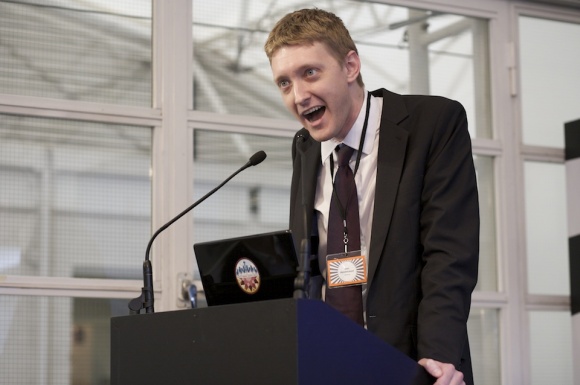
Ben Hendrickson – Ranking Models: Just the stats, on the rocks please.
- Placement of keyword: How does it affect rank?
- average number of inbound links does not correspond to rank: followed links
mean index by number of links better but still not flat: there are other things which matter - mozrank and external followed links have almost the same bell curve!
- different than unique domains linking
- keyword tag does not match rank
- title tag matching does work but less than body or out anchors
- putting keyword phrase in path and filename matches have a negative factor!
- keyword in domain helps
- h2 seem to be less useful than h1
- problem with subdomains and paths is that a lot of sites are spammy which are doing it
- average number of inbound links does not correspond to rank: followed links
- Different qualifications for different SERP position:
- high quality links are important at the top
- down on the second page, more links seems to help
- alt text matching the keyword really seems to help, more than bold. sites which have alt tags have been heavily seo’d.
Analysis by Foliovision
Ben is the guy who developed SEOmoz’s amazing Linkscape, a parallel search index always full of the most recent two months data. SEOs everywhere owe Ben a debt of gratitude for that major accomplishment. Thanks, Ben. Unlike most of us Ben has a lot of accurate and recent data to look at.
Ben’s presentation was very dry. It’s difficult to tell if Ben is sending himself up as a geek or is in fact the bright guy with reduced social skills he pretends to be. Perhaps he feels we’ll think less of his programming if we think more of his social skills. Our programmers at Foliovision are so relentlessly extrovert (Peter is a martial arts expert and swimmer, Martin is lead singer/guitarist in a death metal band) and at the same time very gifted so I’m not at all persuaded that geekiness and solid code bear any relationship. But in a dark suit and with a shimmering bordeaux tie, Ben looked a whole lot better than our programmers who won’t wear anything except scruffy t-shirts to the office, to the dismay of our rather chic design department.
In the end, Ben gave us less advanced permutations than I would have liked. The bulk of his presentation was just charts of the bell curve for ranking for anchor text in each of the following locations:
- body
- outbound links
- h1, h2, h2, h3
- page title
- path
- with distinction of path length, as Google seems to have a negative filter for very long URLs
- domain
- subdomain
Positive were domain, page title, body and outbound links (counting outbound link text is cheating as outbound links are almost always in the body and had almost exactly the same curve, so the factor at play was probably body). Shocking to us SEO types, the header tags didn’t seem to have a positive effect, while subdomains actually had a negative effect.
I’m not surprised subdomains had a negative effect, as they are often used by spammers and grey hat SEO. Ben suggested the Linkscape database is relatively clean but it would not be suprising if a fair amount of subdomain spam would have managed to make it in. So the stats on anchor text in subdomains is effectively a highly spam-charged subset. On clean domains, perhaps anchor text in subdomain does help.
Ben didn’t give us the data I wanted: which is taguchi type curves for different combinations of the above locations. I think he could generate from the stats he has and I look forward to seeing it at some point.
Ben was one of the few who felt comfortable with and encourages live questions. His ability to handle questions off the cuff is commendable. Someone from the audience said that keywords in domain name are overrated as carinsurance.com doesn’t rank number one. People accepted that evalaation but I don’t agree.
My superficial check as someone who works in the insurance field showed that carinsurance.ca does rank towards the top #3 in canada.ca. In Google.com, domains with carinsurance in the root rank 3 x in top 25. Otherwise those SERPS are quite full of famous insurance brands, all with a lot more link juice.
For the moment, exact domain match appears to be the elixir to quick high rankings in Google. I wouldn’t bet millions on ranking with an exact domain name strategy as Google will reevaluate ranking factors whenever any given factor has been sufficiently polluted. Moreover the exact domain name ranking bonus appears to only really apply to .com’s.
I was really happy to see some hard data, even if it was incomplete. Perhaps Ben will release some more sophisticated analysis at a future point.
Live linkbuilding – Tom Critchlow (Head of Search, Distilled) & Rand Fishkin (Founder, SEOmoz)
Tom
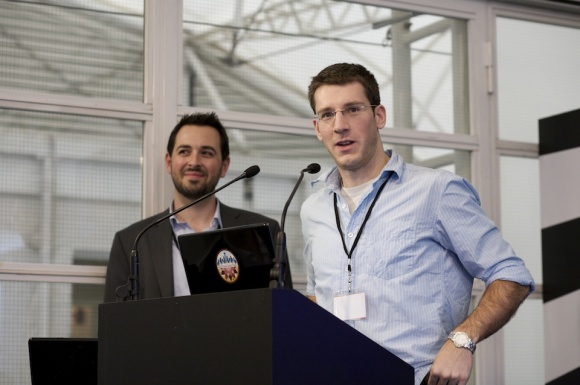
Tom Critchlow and Rand Fishkin – Live Linkbuilding
- Example site: sixt.org
- lowhanging fruit
- get some links on wikitravel.org
- none of the official wiki sites pass link juice, but wikitravel does
- research.microsoft.com – links to avis but not six
- enjoyengland.com – sixt is not on the page
- edinburgh.org – sixt is not on the page
- query on the board not shown long enough to write down: [instanbul car hire -intitle:hire
- get some links on wikitravel.org
- NICHE APPEAL STRATEGY
- “ski car hire”
- create niche content
- “ski car hire”
- Google local
- lowhanging fruit
- Example site: ARENAFLOWERS.com
- low hanging fruit: top competitor interflora
- visa europe
- weddingdaze.co.uk
- anyone linking to an expired page can link to you instead: coming from tesco.com/flowers
- special asset: ethical supplier
- fairflowerflairplants
- not doing much with the weblog
- badges – what flower are you
- hidden meaning in types of flowers
- data visualisaton, the colour of flowers over the year
- flower photos, high res
- animals that look like flowers
- wedding directionrs: a gazillion of them
- low hanging fruit: top competitor interflora
Rand
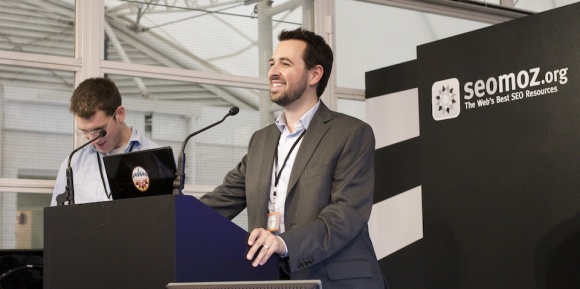
Tom Critchlow Rand Fishkin – Live Linkbuilding
- Example site: avg.com
- #1 on google.com but #3 on google.co.uk
- get onto news results with one of team weblogs
- 43 million places to have a link: look for key term minus company name, i.e. “antivirus -avg” or “free software list -avg”
- Example site: brickhunter.com
- use keyword match tool [exact!] to find the keyphrases you need
- ehow only has five links to page: ranking on domain authority only
- few anchor texts from high quality domain (dozen or two dozen links rather than lots of spammy index)
- the more of a pain in the ass, the better the link
- competitive link finder finds links in a hurry
- do a diy weblog could help
- How to do live analysis?
- do a google search
- use Moz toolbar analyze page against number one and your own page: delta between yourself and competitor for backlinks and trust factors.
- Example site: portugese yellow pages: http://www.pai.pt
- badges that they are listed in this directory (try this for sitereviewer.net)
- contact your local government people to link to from lisbon tourist boards
- use rebranding as an excuse to contact them again
- mechanical turk (not for comment spam nor for link building): but use it to find web addresses or all the cities that you need – $40 for contact list which would take a week to build.
- virtualpa or for mechanical turk you can use if you put in a US address
- backlink tool: index is a month behind
- don’t use robots.txt and meta no index (do one or the other), as you can end up knocking your site out of Google
- when you build a site with search, take people straight to the category page: never show them the search page but take them to the category page
- Example site: Wealth management – http://www.aag.co.uk/
- How to fix your site
- which.co.uk good targets
- build a manual list of financial news sites and submit to them
- create javascript charts included in people’s pages (people will embed this kind of content)
- outranked by aag.org (American geographers) for own name: lots of trusted links from the government
- visualizing linkscape data
- radar chart view of strength
- long way to go before you eclipse collinstewartwealth.com
- copying grey hat looks good but often ends in tears: competitor gets dropped and then so do you.
- seo friendly pr links
- in your pr, getting awards asking for links
- press releases with photos with bill gates
- brand for your name and your keyword: ie. “aag wealth management” rather than just company name.
- How to fix your site
Analysis by Foliovision
The head to head live linkbuilding session showed us two good SEO minds in action on fresh problems. Just seeing the spontaneous and quick brainstorming on how to improve a given site’s position gave a lot of fresh insight into how one can approach a site.
For those who work for years on the same clients or heavens forbid in-house seeing rapid analysis can be as refreshing as a dip in a mountain stream.
Particularly interesting is how many sites qualify for trusted local links from their local municipal government. Also notable: how many link building strategies require going back and creating:
- great content (weblog/tips)
- great tools
- newsworthy events
Making sure that a company is always identified as their name plus keyword term is a key insight as well. Makes many of the incoming links valuable.
Conversion rate optimisation – Ben Jesson and Dr. Karl Blanks (Directors, Conversion Rate Experts
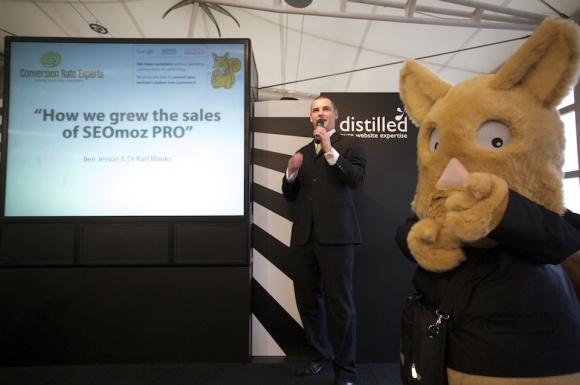
Ben Jesson – Conversion Rate Experts: the squirrel passed out from heat exhaustion but Ben kept on ticking
- if you want to dominate your market, don’t start with the best seo start with best product.
- work hard, implement, be bold.
- google optimizer: great way to test. which part of the page to test.
- 101 ways to use google optimiser: link bait going mental
- loads of links, lots of inquiries
- Tom Leung: Google itself contacted us: said no to Google
- website optimizer consultant
- 101 ways to use google optimiser: link bait going mental
- seomoz, seobook all clients: same process on all clients
- weight loss 67% increase
- at end of day optimisation is not about the tools: it’s about what to test.
- 50 tests on landing pages but never tested thank you pages.
- understanding why your visitors are not converting
- which changes can genuinely double your conversion rates?
- creating your experimental strategy
- objection: counter objection.
- if they don’t trust your company, you have to build trust elements
- if they don’t believe your product, then show advantages
- if they don’t understand, improve comprehension
- if you aren’t making enough offers, make more offers
- What your visitors want, and why they are abandoning.
- tools: live chat – check livechat transcripts
- tell a friend
- google analytics: what page is abandoned
- kampyle: tells you why visitors abandon website
- perceptions: did you find what you are looking for
- seomoz customers
- surveyed: paying members, non-paying members, cancelling members
- learning from face-to-face selling
- method marketing: we became the customer – get into the customer’s mindset. the best fishermen think like the fish, not like the other fishermen.
- usability tests: used twitter to find testers
- split tests: omniture test & target
- tricks to get honest feedback: Not “How do you like my new website?” but “I’ve just paid a guy 20 grand to redesign my websites and I don’t like it much.”
- things to find out
- what keeps customers awake at night
- going through your website with salespeople
- listening to customer calls
- get reports on the FAQs
- learn from face to face selling
- weight loss
- method marketing
- which companies had great long term rates
- carl joined weight watchers: slimmer of the week, second of the week – able to write much better copy
- doing bingo: played bingo. spent time with the players.
- What visitors want and what companies want
- selling fishing boats: what the visitor wants looks at boats and maybe buy one
- company just wants to sell one
- but instead become trusted advisor: offer valuable free reports, offer useful selection tool, have a forum
- give them a reason to give you their email address.
- sell them a boat later but first become trusted advisor:
- first give them a reason to give you their email address:
- free reports
- selection tool
- forum
- first give them a reason to give you their email address:

Ben Jesson – Conversion Rate Experts
- Sales page length
- sales pages need to be very long: even longer than face to face sale. you have to hit every objection as a single objection will blow the sale.
- perception consumers don’t like long sales pages.
- Amazon uses long pages and nobody even notices.
- TIP: make your advert valuable as people will want to read on. don’t sell, add value.
- Personality
- use video to make the sale, as rand is a very likeable type.
- johnson box with table of contents
- Credibility
- use references from big clients.
- use media mentions: get credibility before starting to make the sale.
secret weapon with brand names.
- Benefits: what do you get?
- use tools on any website on demand
- find out why your competitors are ranking above you and then beat them
- learn what it takes to become an advanced seo (prestige)
- Q & A feature on sales page
- Testimonials: essential elements
- highlighted phrase
- full text
- picture
- credentials
- You can never have too many testimonials, especially good ones.
- Call For Action:
- reason for urgency: lock in price now.
- improve your rankings now: call to action. surprising results with minimum amount of change, call to action.
- add a guarantee, include in call to action.
- no minimum term – cancel any time.
- Potential upsell, variations of yes: Three options.
- TIP: don’t add .00 unless you want the number to seem big
- do add .00 to free report value.
- numbers that end in nine outperform numbers that end in zero.
- Results: 52% more customers.
- TIP: don’t add .00 unless you want the number to seem big
- then driving more traffic at that page.
- $1 offer campaign
- *only to existing subscribers
- How to write emails to convert:
- write first draft in your own email client
- write to a particular person
- benefits
- no waffle
- avoid “used car salesmanship
- very personable not like a marketer
- write like a real person to a real person.
- gather objections: over 100 emails as to why they didn’t want the offer.
- post sale email campaign: 10 steps to competitive advantage: teach people to use the tools which they are trying.
- 10 times as many new clients: with trust with customer base you care about.
- doubled the number of paying subscriptions. Most people stayed. In part thanks to post-sale follow-up.
- More conversion tips at: 108 conversion tips, 14 free conversion tools

Dr Karl Blanks – Conversion Rate Experts
Analysis by Foliovision
Ben Jesson is fast talking salesguy. Perhaps the only one at the conference. You’d like to condemn his methods, especially when you learn that one of conversion optimisers greatest success stories is in weight loss (only one diet works long term: eat less, do more sports – all the rest is smoke and mirrors).
On the other hand, Rand Fishkin gave Conversion Rate Experts his highest personal recommendation for what they did for SEOmoz after several other conversion specialists worked on the SEOmoz offer and landing page. And Ben gave so many useful tips, you can’t blame him for tooting his own horn. Dr. Blanks was a little bit less animated but his email advice is just as good.
There are a lot of notes above, but all of which is written down are things we do or should be doing for our clients. Every time we’ve implemented anything on this list, sales have gone up. Reread the testimonial advice. And then reread it again. And then do it, just as Ben has outlined it. It’s absolutely right on.
Ben’s first remark is worth keeping close to one’s heart:
If you want to dominate your market, don’t start with the best seo start with best product.
Some of the Q&A

SEO Expert Day One Q A
What do you look for in a junior seo?
- Richard: Attitude and aptitude: problem solving abilities, their own interests. Not experience on day one. Interactive ability with other people, outgoing communicative. They have online presence.
- Will: people who are good at searching. Know how to use google and the web. Either stats or creativity.
When you rank highly on organic side should you cut back PPC?
- Will: Not much interesting stuff written about PPC. Measuring and testing.
- Alec: Brand lift and conversion lift with both ppc and organics.
- Rand: Cannibalisation balances itself out.
How dangerous is it to have resource sections?
- Jane: Good sites link to good sites. Spammy sites, link to spammy sites.
Only link to quality sites, it does reflect well on you. - Ben: don’t link to bad stuff.
How should I use Facebook to build a social media campaign?
- Lucy: are you sure you want to run a facebook campaign? Develop your own stuff first. Pimp your facebook page. Blog already up and running on Facebook. Quizzes on facebook. Facebook app. TIP!: On some facebook pages you can get a live link!!!
- Jane: make sure ad only shows to target audience. women between 18–27, not men in new zealand.
- Will: Treat facebook like email.
- Denny: facebook ads are really cheap. dig down in demographics. test in facebook.
- Will: get to 100 fans, get custom url. trademark. You can only change URL once.
- Tom Critchlow: Work with trusted users in social media. Somebody with genuine friends and followers. Much more likely to do something about it. Get linkerati or facebookerati.
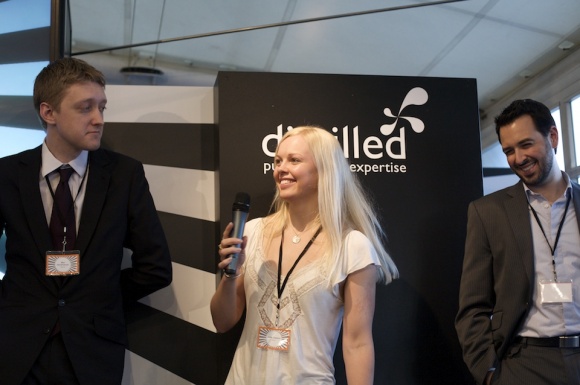
Ben Hendrickson – Jane Copland – Rand Fishkin
Project management tools for SEO?
- Rand: project management for seo: Raven SEO. SEO task management. Large networks.
- Jane Copland: built our own. built something yourselves.
- Will: check out buzzstream.
- Richard: don’t invest much in tools. Tab for link acquisition in Firefox utility.
- Tom Critchlow: regular project management, use any tool. seo projects wildly different from one another. Project management tools for seo set up in specific way. Not exactly your workflow. Don’t go too far down that root. Use common sense.
- Jane: All project management in Basecamp and Excel.
How big are your SEO teams?
- Jane: We are about four or five seos out of office of 15.
- Ben: We have five at seomoz. I use omnifocus.
How can you tell if a social media campaign will not work?
- Lucy: If there isn’t a community which already exists, it will make it a really hard work. tried to do a campaign for Flashpoint TV show. No online community so quizz wouldn’t work. Make sure there are people who are interested in what you are talking about.
- Jane: I wrote a post called 27 observations of a recent expat. Didn’t push it as social media. Four months later stumbleupon catches on. 2000 people per day. Less easy to manipulate than seo. Comes through after the fact.
- Danny: Can be frustrating. Last minute stuff works and huge intense projects don’t work.
End of Day One
That’s the end of day one. I’ve been travelling and catching up today. Day two will have to wait for tomorrow.
Some Other Reviews of SEO Pro Training Seminar 2009

Alec Kinnear
Alec has been helping businesses succeed online since 2000. Alec is an SEM expert with a background in advertising, as a former Head of Television for Grey Moscow and Senior Television Producer for Bates, Saatchi and Saatchi Russia.
Hi Alec,
thanks for your great report from SEO Expert Training live conference and also for your comments and your visions. This article helped me to categorize and better understand information about SEO I have had and also it gave me a lot of knew stuff to think about and work on.
Best regards
Adam
This is fantastic Alec. Thanks for doing all the heavy lifting on this.
Fascinating. Complicated. The word “product,” is like a blow to the back of head, though. Or maybe it just sounds like contraband.
Phenomenal write-up Alec – really, very much appreciated. Must have taken ages!
I didn’t attend but hope to next year. Interesting to hear such an honest account.
Cheers Alec,
Ben
Thanks to you Alec and the team at Foliovision. Even years later, it is still a valuable insight on one of the best SEO workshop available.
On a personal level, I like your comments on the Public speaking abilities of the different guests.
/Hervé